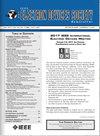具有高线路灵敏度和电源抑制比的p-GaN HEMT基准电压
IF 2.4
3区 工程技术
Q3 ENGINEERING, ELECTRICAL & ELECTRONIC
引用次数: 0
摘要
本研究展示了基于p-GaN HEMT技术的单片集成电压基准。所提出的两级结构可以提高在较宽的电源电压和温度范围内产生的参考电压的稳定性。在不同温度下测量了其静态和动态性能。实验结果表明,当电源电压从2.8 V上升到40 V时,输出电压稳定在1.3 V,室温下的线路灵敏度为0.035%/V。当测量温度升高到$250~{^{\circ}}$ C时,产生的参考电压略降至1.25 V,温度系数为- 22.1 ppm/°C。该作品的电源抑制比为−46.64 dB ~−56.2 dB,噪声频率为10hz ~ 5mhz,具有一定的竞争力。当频率超过5mhz时,产生的参考电压的电压变化相对较小。结果表明,所提出的工作特别适用于需要热稳定偏置电压且对电源电压变化具有高抗扰度的全氮化镓单片集成电路。本文章由计算机程序翻译,如有差异,请以英文原文为准。
A p-GaN HEMT Voltage Reference With High Line Sensitivity and Power Supply Rejection Ratio
A monolithically integrated voltage reference based on p-GaN HEMT technology is demonstrated in this work. The proposed two-stage structure can improve the stability of the generated reference voltage over a wide range of the supply voltage and temperature. The static and dynamic performance was measured at various temperatures. Experimental results indicate that the output voltage is stable at 1.3 V when the supply voltage rises from 2.8 V to 40 V, with a line sensitivity of 0.035%/V at room temperature. When the measurement temperature increases to $250~{^{\circ }}$ C, the generated reference voltage slightly decreases to 1.25 V with a temperature coefficient of −22.1 ppm/°C. The power supply rejection ratio of this work is competitive, as the power supply rejection ratio changes from −46.64 dB to −56.2 dB, in which the noise frequency varies from 10 Hz to 5 MHz. The voltage variation of the generated reference voltage is relatively small when the frequency exceeds 5 MHz. The results show that the proposed work is particularly suitable for all-GaN monolithic integration circuits that require thermally stable bias voltages with high immunity to the supply voltage variation.
求助全文
通过发布文献求助,成功后即可免费获取论文全文。
去求助
来源期刊

IEEE Journal of the Electron Devices Society
Biochemistry, Genetics and Molecular Biology-Biotechnology
CiteScore
5.20
自引率
4.30%
发文量
124
审稿时长
9 weeks
期刊介绍:
The IEEE Journal of the Electron Devices Society (J-EDS) is an open-access, fully electronic scientific journal publishing papers ranging from fundamental to applied research that are scientifically rigorous and relevant to electron devices. The J-EDS publishes original and significant contributions relating to the theory, modelling, design, performance, and reliability of electron and ion integrated circuit devices and interconnects, involving insulators, metals, organic materials, micro-plasmas, semiconductors, quantum-effect structures, vacuum devices, and emerging materials with applications in bioelectronics, biomedical electronics, computation, communications, displays, microelectromechanics, imaging, micro-actuators, nanodevices, optoelectronics, photovoltaics, power IC''s, and micro-sensors. Tutorial and review papers on these subjects are, also, published. And, occasionally special issues with a collection of papers on particular areas in more depth and breadth are, also, published. J-EDS publishes all papers that are judged to be technically valid and original.
 求助内容:
求助内容: 应助结果提醒方式:
应助结果提醒方式:


